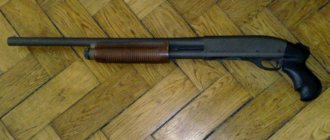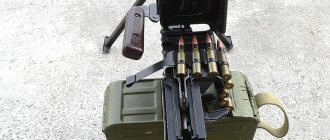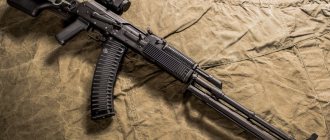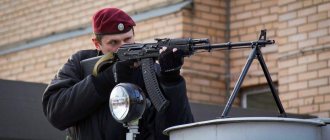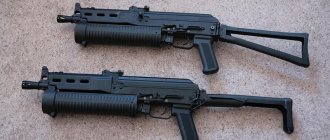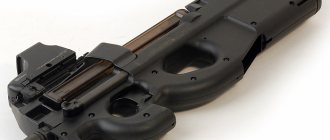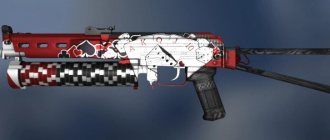DShK machine gun The DShK machine gun is a Soviet heavy machine gun using a 12.7x108 mm cartridge. The weapon was created on the basis of the DK machine gun and is rightfully one of the most common heavy machine guns, which played a significant role during the Second World War and other subsequent military conflicts. This machine gun posed a huge danger to the enemy both on land, sky and sea.
Today, the machine gun has been completely replaced by the more modern and technologically advanced Kord and Utes.
This is interesting: The DShK machine gun in the army received a unique nickname “Dushka”
History of creation
In 1929, the Soviet gunsmith-designer Degtyarev received the task of creating the first large-caliber machine gun to combat primarily enemy aircraft at altitudes of up to 1,500 meters. Almost a year later, the master provided his 12.7 mm machine gun for testing. Already in 1932, small-scale production of this weapon was launched under the symbol DK (Degtyarev, large-caliber).
DShK machine gun
Due to the fact that the weapon had a number of significant shortcomings - enormous weight, large dimensions, low rate of fire - its production was stopped in 1935. Next, the designers were busy modernizing and improving the machine gun. For example, in 1938 Shpagin invented a belt feeding system. 4 years later, on February 26, 1939, after modifications, the machine gun was adopted by the Red Army under the designation DShK - Degtyarev-Shpagin large-caliber.
DShK 12.7 was produced at the Kovrov Mechanical Plant since 1940. Production was curtailed only in the post-war period.
DShK machine gun
This is interesting: In total, at the end of the Second World War, 9,000 weapons were produced.
In 1946, the DShKM appeared - a modernized DShK machine gun (the barrel mount and the belt feed design were changed). It was used as an anti-aircraft machine gun on the T-54, T-55, T-62 and T-10 tanks under the designation DShKMT.
What happened
But the thing is that the next tests in 1934 revealed one unpleasant feature of the new gun: it turned out that the machine gun was virtually useless to fight even relatively fast targets (especially airborne ones), since the rate of fire was extremely low, and the magazines offered by the manufacturer were so heavy and uncomfortable that even experienced fighters experienced many difficulties when handling them. In 1935, a decree was issued to completely stop all production of DC.
The situation of the practically rejected gun was saved by the outstanding domestic gunsmith G.S. Shpagin, who in 1937 invented a belt feed mechanism, the installation of which did not require any serious alteration of old machine guns. In April of the following year, the new design was successfully tested at the factory, in the winter the sample passed tests with flying colors with honor, and in 1939 the DShK machine gun “officially” appeared.
Design
The automatic operation of the machine gun works by removing powder gases, and the barrel is locked by two larvae attached to the bolt.
The machine gun's barrel is non-removable, has a muzzle brake, as well as ribs for better cooling. The fire mode is automatic only.
DShK coaxial machine gun
Fire control occurs using twin triggers and two handles on the butt plate.
The butt plate of the receiver contains spring buffers for the bolt and bolt frame.
Initially, the machine gun's ammunition system was of the drum type. The cartridges were fed from the left, from a non-loose metal strip. When rotating, the tape feed device (drum) performed two functions: it simultaneously fed the tape and removed ammunition from it using a lever located on the right. When the lever was pressed with the charging handle, it oscillated in the vertical plane.
Later, the drum mechanism was replaced with a slider mechanism, which worked in a similar way - the bolt fed the cartridge into the chamber after the chamber with the cartridge came to the lower position.
DShKM machine gun
The machine gun sight is frame. The anti-aircraft machine gun has an angular sight.
DShK uses a universal, extremely weakly mobile Kolesnikov machine with removable wheels and a steel protective shield. The wheels and shield of the anti-aircraft DShK were removed, and the tripod was moved to the sides.
What were they used for?
Since there were few machine guns, they became the main type of anti-aircraft weapon: they were not used so often to combat ground targets. However, in the first year of the war, the Wehrmacht constantly threw light tanks and wedges into battle, against which the DShK was a formidable weapon, and therefore machine guns were “requisitioned” from anti-aircraft units.
Later, these weapons began to be transferred to anti-tank units as a matter of routine, as fighters used them to fight off attacks from enemy attack aircraft. In urban battles, the DShK turned out to be much more in demand specifically for combating enemy personnel. It often happened that it was very difficult to “pick out” Germans from a simple brick house (due to the lack of grenade launchers at that time). But if the assault group was armed with a DShK machine gun, the caliber of which made it possible not to pay special attention to the walls, then the situation changed dramatically for the better.
Modifications
- DShKT is a tank version of the machine gun. It was first installed on the Soviet IS-2 heavy tank as an anti-aircraft weapon.
- MTU-2 is a twin turret for Navy ships.
- DShKM-2B is a twin installation for installation in the turret of boats.
- P-2K - silo installation for submarines.
- DShKM-4 is a prototype of a quad turret (quad version).
DShK anti-aircraft
“Simply a monstrous Russian machine gun”
These are the words that Larry Vickers, a world-famous weapons expert, accompanied the shooting from the DShK these days. But let's see how the combat use of the DShK went.
Built anti-aircraft version
Before the war, they managed to collect only a little more than 2 thousand DShK. They went mainly to the navy as anti-aircraft, and to the ground forces. However, with the outbreak of hostilities, it became clear that the new machine gun was quite a powerful thing. For example, the DShK easily hit any German armored cars and light tanks, and under certain conditions could penetrate the rear or side armor of medium tanks of early series. The DShK was good to fight against sharp shooters or enemy gun and machine gun crews, and, of course, it was convenient to use it as an anti-aircraft machine gun.
On the IS-2 tank
During the war years in Kovrov, and then in Kuibyshev, where production was evacuated, the production of DShK was significantly increased compared to the pre-war rate. It turned out that everyone needed the new, and most importantly, the only one in the Red Army, heavy machine gun and was very effective. Its anti-aircraft variants were manufactured in single, twin and even triple versions. And during production, a tank version appeared - DShKT, at first it was planned to be installed on many vehicles, but it only came to the light amphibious T-40. But since 1944, a characteristic ribbed barrel with a flame arrester appeared on the roof of the turret of the IS-2 heavy tank. The heavy 12x7 by 108 mm cartridge allowed IS crews to fight the notorious German “Faustniks” directly through the walls of houses during the assault on cities. The powerful DShK cartridge easily penetrated double brickwork. And Hans Ulrich Rudel, a famous anti-tank pilot, himself wrote that during a raid on a column of Soviet heavy tanks, one of the machine gunners, clearly not a timid dozen, landed an entire belt on his plane, with one of the hits pierced the skin and crushed the ace’s leg like this that she had to be amputated. It’s a pity, of course, that not the whole line went where it should.
On a T-72 in Syria
By the end of the war, based on experience in operating the machine gun, a modified version was developed - the DShKM, which entered service after the victory. The DShKM was and is in service with almost a hundred(!) countries of the world. Before the appearance of the Utes machine gun, which replaced the DShKM, our first large-caliber continued to stand on the roofs of Soviet tanks. The machine gun has been used in all military conflicts since World War II without exception. Compared to its main competitor, Browning, the DShK is more reliable and unpretentious, as well as easier to maintain. For example, if a fighter has problems with the charging handle, you can use a cartridge case instead (it fits perfectly).
DShK in the back of a pickup truck, a very popular option in Africa and the Middle East
A machine gun effective at 2-2.5 thousand meters always caused a lot of trouble for the enemy. Since the production of DShKM was localized in some ATS countries, China and North Korea, these barrels ended up, for example, among dushmans during the war in Afghanistan. From them, the Mujahideen could shoot down Soviet helicopters and even airplanes, which added headaches to our command. These days we see DShK and DShKM in Libya, Syria, Ukraine... however, wherever it’s hot. And although the Russian Army has already abandoned the first large-caliber weapon in favor of its successors “Utes” and “Korda”, something tells us that for a long time we will see in news videos the characteristic corrugated barrel and round flame arrester, which cannot be confused with anything.
Cover: pinterest.ru
Combat use
The DShK can rightfully be called a world weapon, since it took part in almost all local conflicts.
Using the DShK machine gun
It was most widely used during the Second World War as both a heavy and anti-aircraft machine gun. Due to its large caliber, the machine gun effectively fought even against medium-armored enemy vehicles. At the end of the war, it was massively installed on the turrets of Soviet self-propelled guns and tanks for self-defense against aircraft and infantry.
It was used in the Afghan War by both Soviet troops and the Mujahideen, who, with its help, managed to shoot down several helicopters and Su-17s.
Using the DShK machine gun
Quite widely used in the civil war of Syria and Libya, during the Chechen war (by the Chechens).
Since 2014 it has been used during the armed conflict in Donbass in Ukraine. Some brigades have standard equipment.
Anti-aircraft variant
In particular, it turned out to be insufficiently stable. A limited series of special anti-aircraft machines with comfortable bipods and additional sighting devices were developed and made, but they never went into production (due to the difficulties of the war years).
Special, balanced anti-aircraft installations were also developed. For example, the DShK coaxial machine gun was quite popular. Difficulties with their serial production were associated with the power supply system: without subjecting the weapon to significant alterations, it was impossible to move the tape receiver to the other side. In the case of using built-in installations, all this created serious difficulties for the gun crew.
Characteristics of DShK
| Weight, kg | 33.5 kg (body) 157 kg (on wheel machine) |
| Length, mm | 1625 mm |
| Barrel length, mm | 1070 mm |
| Projectile | 12.7×108 mm |
| Work principles | removal of powder gases |
| Gate | locking with sliding lugs |
| Rate of fire, rounds/min | 600-1200 (anti-aircraft mode) |
| Initial projectile speed, m/s | 840—860 |
| Sighting range, m | 3500 |
| Type of ammunition | cartridge belt for 50 rounds |
| Aim | open/optical |
Reloading and shooting
A handle for reloading the weapon is rigidly coupled to the bolt frame. The mechanism for direct reloading of the machine gun system also interacts with it, but if the machine gunner inserts the cartridge with the head of the cartridge case, he can do without it. Shooting is done from an open bolt.
It should be remembered that the DShK machine gun allows only automatic fire and is equipped with a non-automatic safety lever, the principle of operation of which is based on complete blocking of the trigger.
The bolt, approaching the breech of the barrel, stops completely, while the bolt frame itself continues to move forward. The thickened part of the firing pin cocks the bolt lugs, which fit into special recesses made in the wall of the receiver. Even after the barrel is locked, the bolt carrier continues to move forward, where its firing pin hits the firing pin. The shutter is unlocked using the bevels of the same frame when it moves backwards.
Features of the ammunition supply of a heavy machine gun
The DShK's ammunition supply comes from a metal link belt on the left side of the weapon. For ease of use, the tape is folded into a special metal container, which is attached directly to the machine gun mount. The drum belt receiver on the machine gun operates due to the handle of the bolt frame. The feeder lever is equipped with a special “dog”, which rotates the receiver drum 60 degrees. Due to this, the cartridge strip was stretched.
As for the ammunition that was used on the DShK machine gun, they had a wide range of names, ranging from armor-piercing to incendiary.
Weapon Features
The DShK machine gun has the following design features:
- The automation operates according to a standard scheme using powder gases. A special feature of the system is the presence of three holes in the gas chamber. Due to the regulator, it was possible to adjust the amount of powder gases, adjusting the operation of the weapon’s automation;
- The machine gun barrel received ribs along its entire length; they were intended to prevent overheating. The muzzle of the weapon received a specific muzzle brake in the form of a parachute. After some time, the muzzle brake became flat;
- The machine gun barrel bore was reliably locked due to the combat stops, the design feature of which was that they were moved in different directions;
- The gas piston rod was equipped with a return spring. Due to the spring shock absorbers, which were located in the butt plate of the machine gun, it was possible not only to significantly reduce recoil, but also to significantly increase the service life of the weapon. In addition, these shock absorbers played another important role - they accelerated the reverse movement of the bolt frame. It was thanks to this design feature that the rate of fire was significantly increased.
Since the new machine gun “jumped” a lot due to the peculiarities of its design, it was soon equipped with a special device that dampened the rebound.
